In the fast-paced lifestyle of today’s society, we often don’t take enough time to acknowledge and to process our feelings. We often think that we always have to keep moving, and that to take time to reflect upon our emotional state is not necessary, or even could imply a bit of weakness. Many choose to ignore and bottle up their uncomfortable feelings, thinking that to disregard them makes them go away.
Psychotherapist Sean Grover has spent his career studying what happens to these repressed emotions within the body. In his research, Grover found that specific emotions tend to manifest themselves physically in distinct areas of the body. This phenomenon is called “somatization”—the tendency to experience psychological distress in the form of physical symptoms.
You may have experienced the connection between your feelings and physical places in your body before. It happens quite often during yoga classes; while stretching certain areas of the body, muscular tensions will relax and we feel a strong release of a certain feeling, which often is tied to a particular past memory or an event. It could come as a rush of sadness, that seems to evaporate from our chest, and afterwards our chest feels profoundly relaxed and our emotional state has a sense of peace we didn’t have before.
This is the basis of psychosomatic therapy; finding the mental and emotional causes of physical pains in the body. A psychosomatic “disorder” is often defined as, “a physical disease that is thought to be caused, or made worse, by mental factors.” While often these physical pains are too broadly attributed to “anxiety” or “stress,” therapists have found that the way the human body functions is a bit more complicated, as each individual emotion can have a strong effect on the physical feelings of the body.
While feelings such as fear and anxiety naturally cause the muscles in the body to tense up, when these emotional states occur for prolonged periods of time, certain muscles in the body can stay tensed, leading to physical soreness and pain. On the other hand, feelings such as love and happiness release the neurotransmitter oxytocin, which causes the body to relax. And the good news is, we can consciously learn to feel love for these areas of our body and help to relax them and to relieve pain. While denying our feelings can keep our selves in a state of inner conflict, warmly accepting our feelings without changing them can allow their release.
These are the 8 places your body stores stress and the emotions that have been found to be connected to each of them:
1. Lower Back: Anger
The lower back is a common place for storing repressed anger. If you regularly experience lower back soreness, stiffness or pain, look into your emotional state and ask yourself if you are carrying any unexpressed anger. To relieve this pain, it’s recommended to first acknowledge your anger and try to understand its cause and which of your needs is not being met that is leading to the anger. Then when situations come up where your need is not being met, learn to constructively and healthily communicate your feelings and needs in order to convert your anger into relief.
2. Stomach and Intestines: Fear
When we’re afraid, we tend to tense our stomach muscles and intestines. It’s no coincidence that certain experiences make us feel “sick to our stomach.” The more one denies or represses one’s fears, the most tension and physical reactions are likely to manifest. To relieve psychosomatic tension in the stomach, try identifying your fears and what is causing them, and talk about them with someone who is a good listener and whom you trust. Grover explains, “The more you can express the fear in words, the less of a hold it will have on your body.”
3. Heart and Chest: Hurt
When someone has their “heart broken,” there’s usually a corresponding strong pain in the chest area. Sometimes chest pains seem to be unexplainable medically, yet when doing therapeutic work, deep and painful memories of past relationships or loss come to the surface. Allowing one’s self to acknowledge and honor the sadness, as well as to mourn the loss, with tears and all, can let these painfully repressed feelings of sadness finally come out into the open and be released, healing the associated chest pain. Focusing on feeling the feeling of love for each hurt part of yourself can also be a wonderfully freeing and healing experience.
4. Headache: Loss of Control
We can’t control everything in life, and part of coming to a mental space of peace is through letting go and trusting that things will eventually work out and be okay. Trying to control everything too much can lead to mental stress and strong headaches. Practice letting go and accepting what you can’t control. The practice of mindfulness can also be wonderfully healing for bringing the attention away from worries and onto the physical and relaxing experiences of the body.
5. Neck and Shoulder Tension: Burdens and Responsibilities
Shouldering too many responsibilities can be a pain in the neck, literally. If you suffer from neck and shoulder tension that has no apparent cause, it’s likely that you’re feeling overburdened. You may have a habit of not asking for help from others and of trying to do everything yourself. To relieve this pain, take some time to write down what is really worth taking on and what is a good idea to get help from others with. Don’t be afraid to ask for help or support, especially when feeling overwhelmed, as we’re only human and everybody needs some help sometimes.
6. Fatigue: Resentments
When holding onto bitterness and anger, more damage is actually done to our own bodies than to the person we’re upset with. As the Buddhist saying goes, “Holding on to anger is like grasping a hot coal with the intent of throwing it at someone else; you are the one who gets burned.” Begin practicing and focusing on the action of forgiveness, and allow your mind and feelings to be free from that which bothered you. Once you’ve made this choice and have moved on through forgiveness, you’ll feel much lighter and happier, and your body will thank you for it.
7. Numbness: Trauma
When we experience a overwhelming physical or emotional pain, we tend to numb our feelings. This is our mind’s way of disassociating from overpowering pain or danger. Traumatic events are not always life-threatening, and can result from both real and imagined dangers, and also especially from a childhood of abuse or neglect. When we don’t spend time ourselves or in therapy processing these events, the painful feelings can become stuck in the body; causing physical pain and even illnesses. Trauma can be a difficult emotional experience to fully heal, and usually takes a lot of time, but an important step is getting help from a professional psychologist. Allowing the feelings to really open into your memory and experience, and to meet them with love, tenderness and softness, can also help to relieve the pain from past traumas. If you’re looking to work to heal the trauma on your own, we highly recommend the book: Self Love The Crown Jewel.
8. Insomnia: Difficulty With Change
When going through life-changing events that cause a high amount of stress, it’s common to lose sleep as the mind is constantly over-engaged. Anxiety occurs when our lives are seemingly unpredictable, and the body would rather stay awake to protect itself from possible dangers than to relax into the safety of certainty. Try discussing your current fears with a loved one or trusted friend, and learn to accept and prepare for change. Once you’ve done your best in your current situation, give yourself some time to relax knowing that you’re taking steps in the right direction.
Have you noticed any physical symptoms in your body that were caused by certain unaddressed feelings and emotions?
Let us know in the comments.
May you embrace the whole of your self and body with love.
You are deeply loved.
See Also: 10 Loving And Proven Ways To Help Cope With Grief
Source: Psychology Today



















